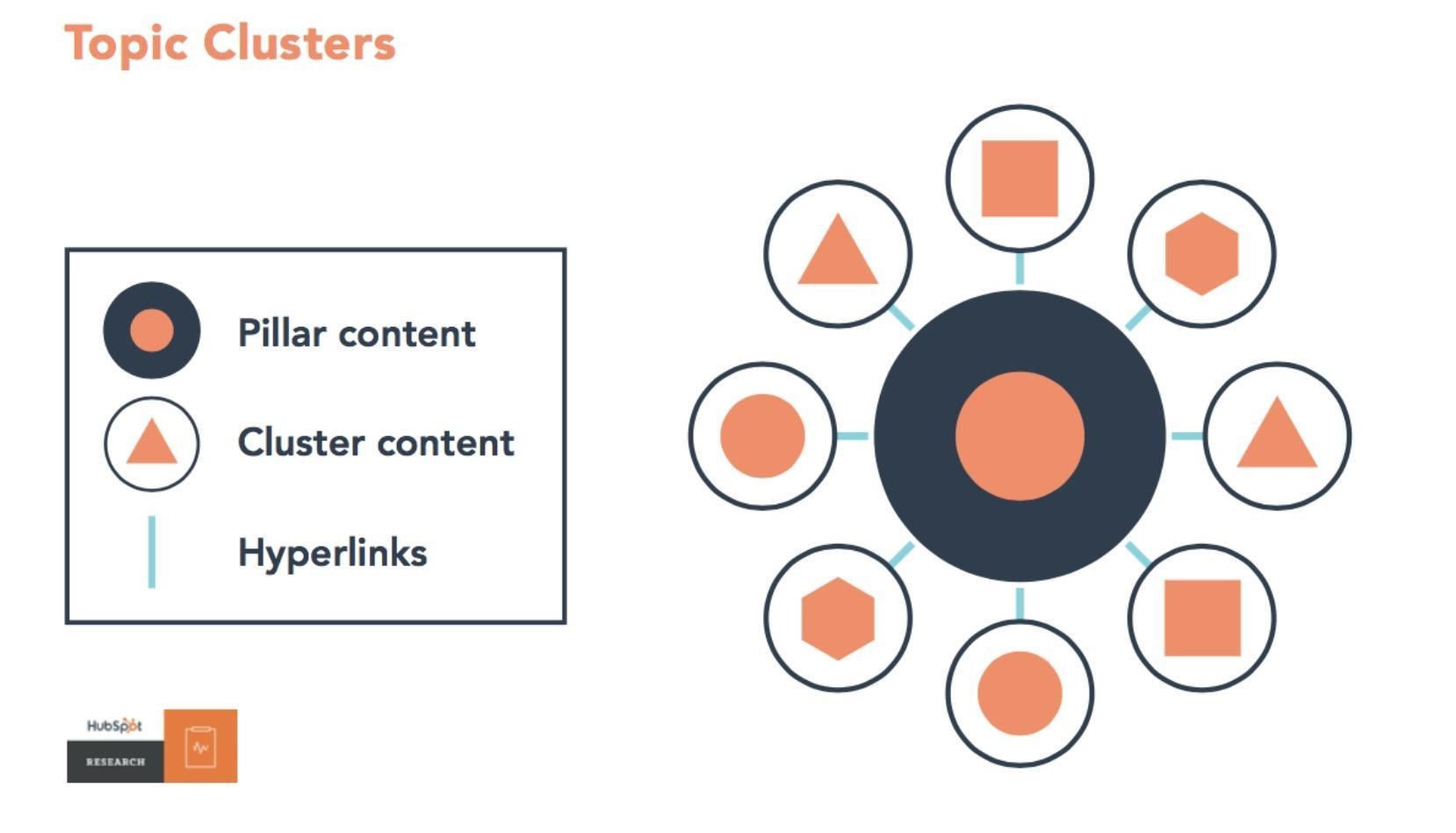
Small businesses often struggle to develop a content marketing strategy that delivers real results in terms of traffic and revenue.
There can be many reasons for this, but typically the limitations are related to:
- level of experience or expertise
- available time, resources, or budget
- longer established or more active competitors
You can follow all of the best practices, copy the biggest brands in your industry, and still spend a lot of money on content that barely generates an ROI.
In this article, we’ll look at potentially more profitable and effective content marketing strategies for small businesses.
We’ll also show you how to use SEO tools to find the best content ideas and how you can develop an affordable content marketing strategy.
Table of Contents
Planning for content marketing success
Generally speaking, the same content marketing rules apply to small businesses that apply to larger companies.
The biggest difference is that you have less room for error and a shorter timeframe to generate value. While larger businesses can throw money at every strategy imaginable and hope some of them work, smaller companies have to be more calculated and maximise every minute of time, every resource and every investment.
The key to developing a profitable content marketing strategy is to plan your approach before you spend anything on content production, and base your plan on evidence instead of gut feeling.
The first step of any content marketing plan is to identify your target audience(s). Draw up detailed customer profiles of the people you want to engage with your content – including their interests, pain points, motivators, demographics, and anything else relevant to the task.
You can begin this process with a few simple questions:
- Who are you targeting? You need a basic understanding of the demographic information that you will typically receive through business data gathered over time.
- What type of content are these users sharing the most? This information is available via your direct observations of social media or social media analytics tools.
- What commonalities can be seen regarding demographics / location / motivation / goals? For example, what cities do your main users comes from, what pages and content do they engage with on your website, and what are the main actions and interactions that they complete when they’re using your website?
Tip: As Google’s algorithm becomes more sophisticated, user search queries are getting longer and more specific. As specificity increases, commercial intent is also intensifying – so delve as deep as you can into the interests, problems, and needs of your target audiences.
Once the audience profiles have some level of detail to build your content strategy around, you need to answer the following four questions:
- On what topics are you an expert? Expertise is what gives you the knowledge and authority to provide high-quality, valuable content for your target audience – and this is becoming increasingly important for SEO (as we’ll explain in more detail later).
- How can you make this expertise relevant? You need to align your expertise with the interests, problems and needs of your target audiences. This enables you to create content that addresses their concerns with messages that inspire them.
- Where is your target audience active? Map out the channels and specific platforms your target audience is most active on – such as Google Search, Instagram, TikTok, YouTube, Spotify (podcasts), Udemy (eLearning), etc.
- Which content will you publish – and where? Determine which content formats are best suited to satisfy the needs of your target audience and which channels to publish them on. Take a look at top performing competitor content too if you’re not sure about the right content format and channels.
If you don’t have some degree of consistency and detail in your audience profiles or lack clear answers to all four of the questions above, investing money in content production risks wasting valuable budget or focusing efforts in the wrong areas.
Where to get content ideas from
Now that you know what kind of content to create and who you’re creating it for, you’ll want to draw up a list of topics and title ideas.
For this, it helps to have a good mix of data-driven research tools to identify the best content opportunities. This stage, like all others, requires gathering evidence, and we do this by collecting the right type of data that’s useful for the task at hand.
Keyword research tools
Keyword research tools are the first place to look for content ideas. For example, you can use Seobility’s free Keyword Research Tool to start drawing up your first keyword list.
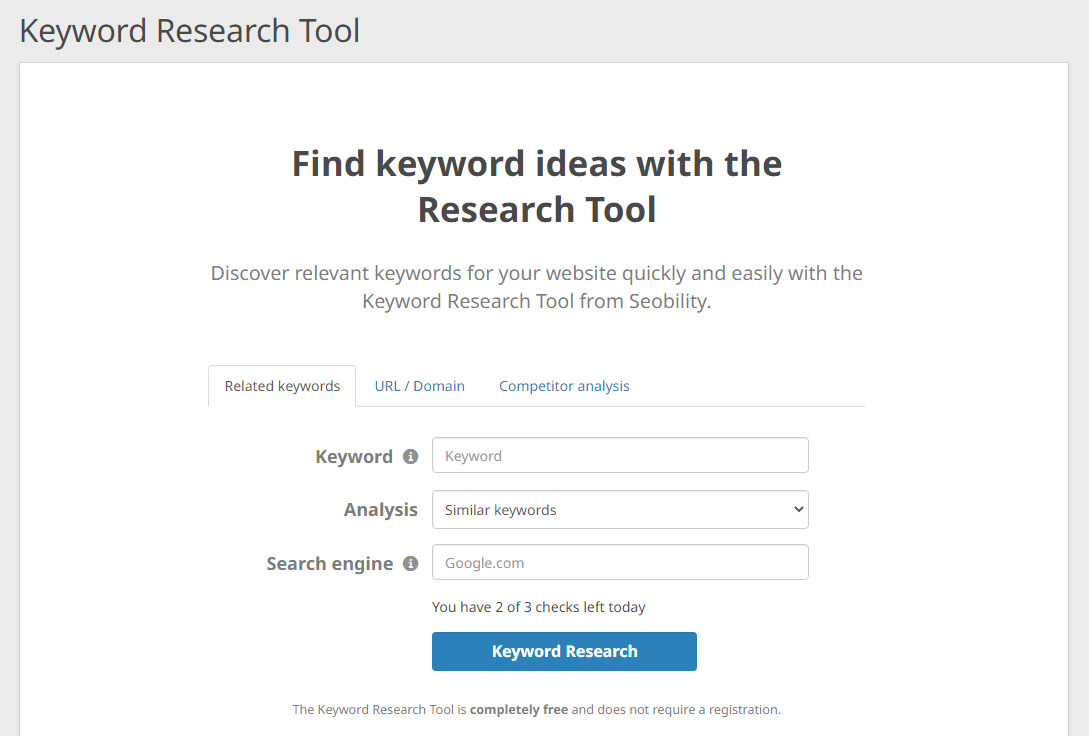
This tool allows you to search for keywords and content ideas based on your primary topics. The suggestions include insights for relevance, search volumes, competition and more – so you can identify high-impact content opportunities to start with. You can make three free searches a day without registration. And if you need more, you can sign up here for a 14-day free trial of Seobility Premium, which allows you to make up to 50 searches per day.
Trend monitoring tools
Trend monitoring tools will help you keep track of interest in topics and identify new topics as they emerge. This is great for checking that your priority keywords and content ideas are still generating enough interest. Trend monitoring tools are also useful for identifying new content ideas that are gaining traction – before everyone else starts optimising for them.

Google Trends is a free, powerful trend monitoring tool and you can get even more insights from adding other data sources from paid options like Exploding Topics.
Competitor analysis
Analysing your competitors’ content strategy helps you make sure you’re not missing anything important: keywords, topics, content formats, etc. It also gives you the chance to identify weaknesses and holes in their strategy that you can take advantage of.
The “URL / Domain” analysis in Seobility’s keyword research tool helps you find high-performing keywords that your rivals are ranking for:
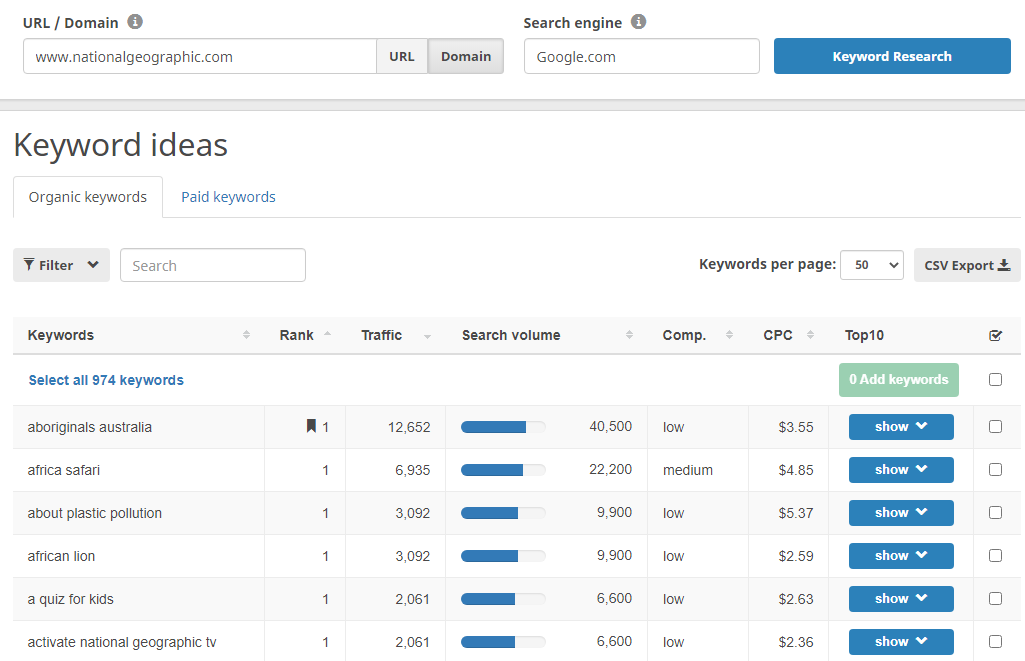
Crucially, competitor analysis also helps you set the benchmark for quality in terms of what it will take to beat your biggest search rivals. You want to focus on doing one thing to the fullest each time, rather than attempting lots of low-impact, limited-value content items at once. Since you are looking to disrupt existing ranking/performing content, you need to aim to provide the most valuable and complete content, suited to the specific audience types you’ve identified, in the most appealing and intuitive formats.
So before you start working on a piece of content, always take a close look at the top-ranking results for that keyword. Take note of the format/angle of the content, the subtopics covered, the media included, etc., and think about how you can make your own content even more helpful and valuable to searchers.
Social monitoring tools
Social media is a great place to get content ideas from, too. The only problem is that manually searching for ideas is time consuming and you don’t get any data insights to help you identify the best opportunities.
However, if you use a social listening platform like Brandwatch, you can keep track of online conversations across social and other platforms, including review sites, forums and other conversation channels. Other tools are also available, including some free options, although they have limitations.
If you prefer to undertake a combination of manual and automated actions, you may wish to search for specific #hashtags on platforms like Twitter, for example, to get an initial understanding of the type of results you’ll receive and the posts being published. You can also look at sites like Quora, which are predominantly question and answer forums, to see content that users are engaging with, as well as the volume and variation of response types, to understand audience sentiment on these topics directly.
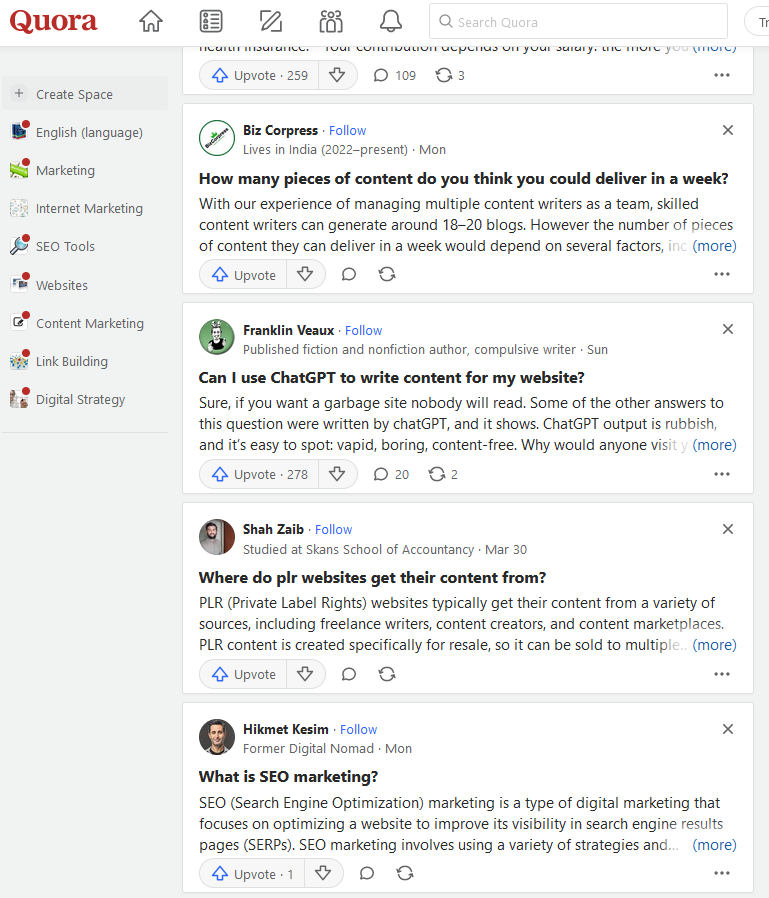
Google Search query predictions
You can also get a lot of content ideas from Google Search itself. To start with, Google’s search query prediction offers up suggestions for any search term you start typing in.
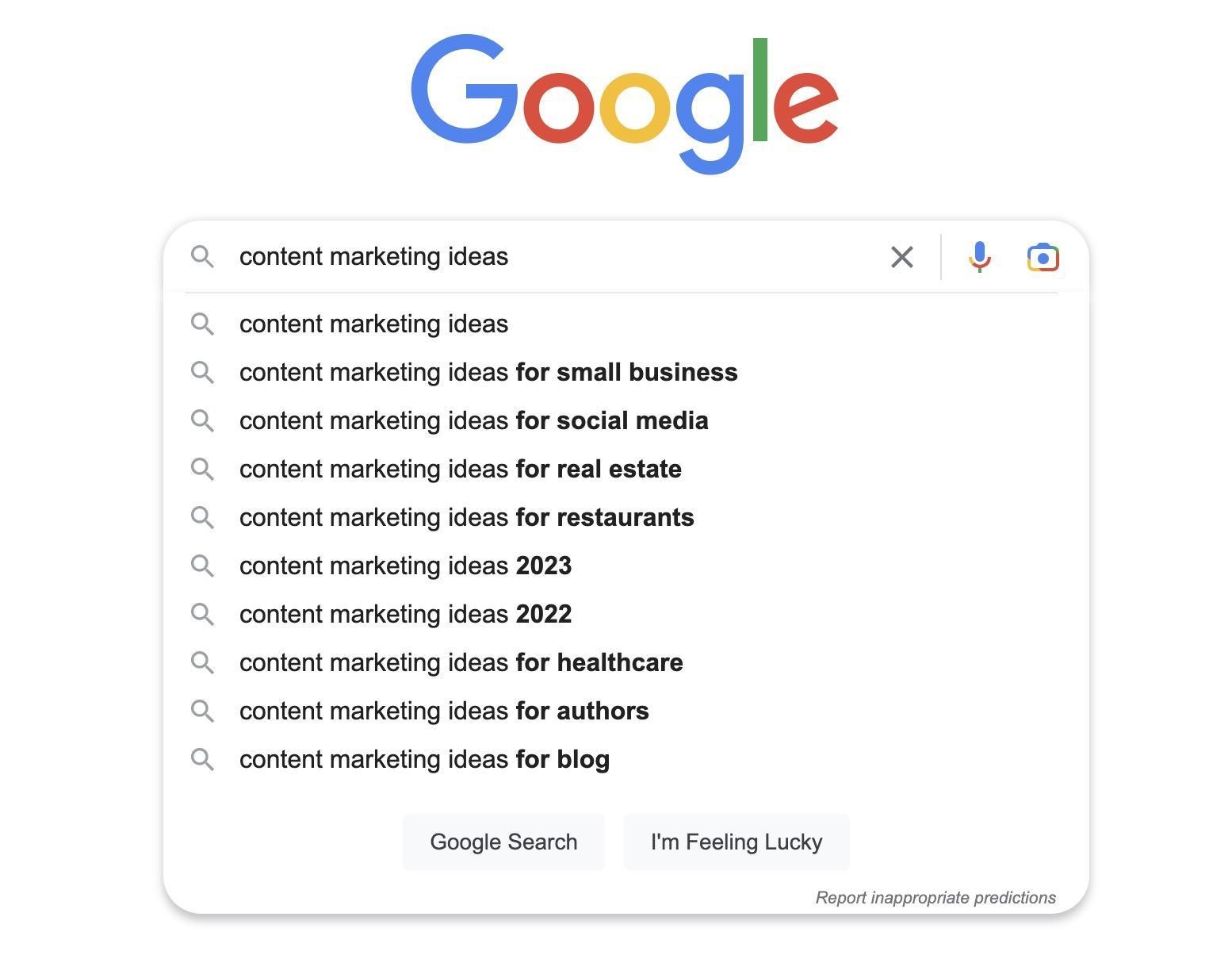
Let’s say we wanted to expand on this article and we typed “content marketing ideas” into Google (above). Immediately, the automatic query completion suggests content ideas for specific industries. We could create a series of posts exploring content marketing ideas for real estate, restaurants, healthcare, etc. This is another example of using evidence (in this case, Google search data and predictive search) to inform and guide your content marketing decisions throughout the process.
Note: With Seobility’s keyword research tool you can also view Google Autocomplete suggestions, along with important data such as monthly search volume.
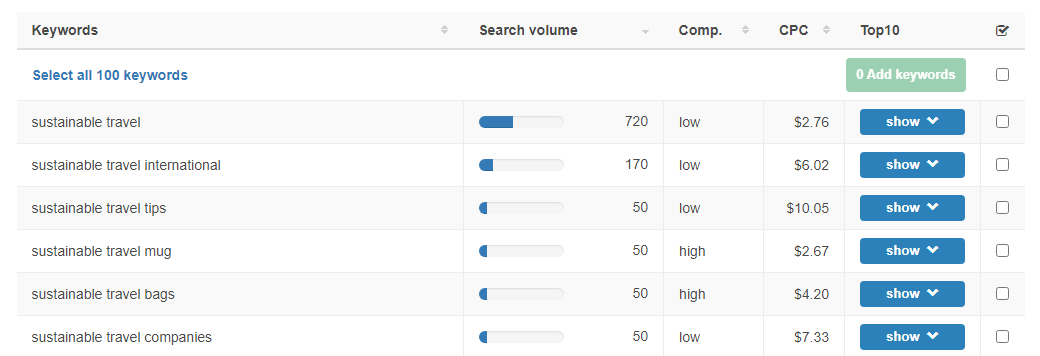
“People also ask” section
The “People also ask” section is another great place to get content ideas from Google Search. Most results pages include this SERP feature, and clicking on any of the questions expands the list to show even more questions.
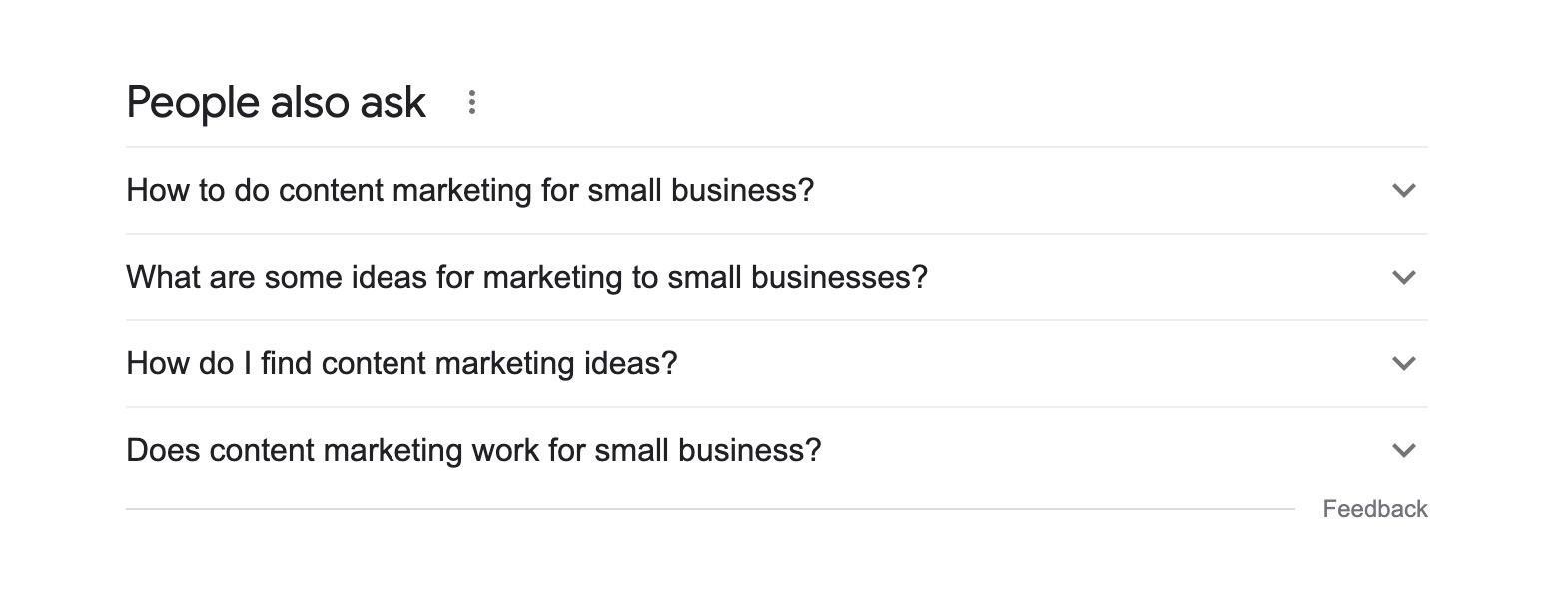
You can also click through to results pages for each question as the search term, which includes another “People also ask” section. Basically, you can repeat this infinitely until you stop getting useful content ideas.
This form of evidence is fantastic for understanding and addressing (with your content) the range of wants, needs, and pain points that your audience cares about.
Related searches
The final SERP feature that can consistently supply content ideas is the “Related search” section, which is normally displayed at the bottom of the results pages for related search queries.
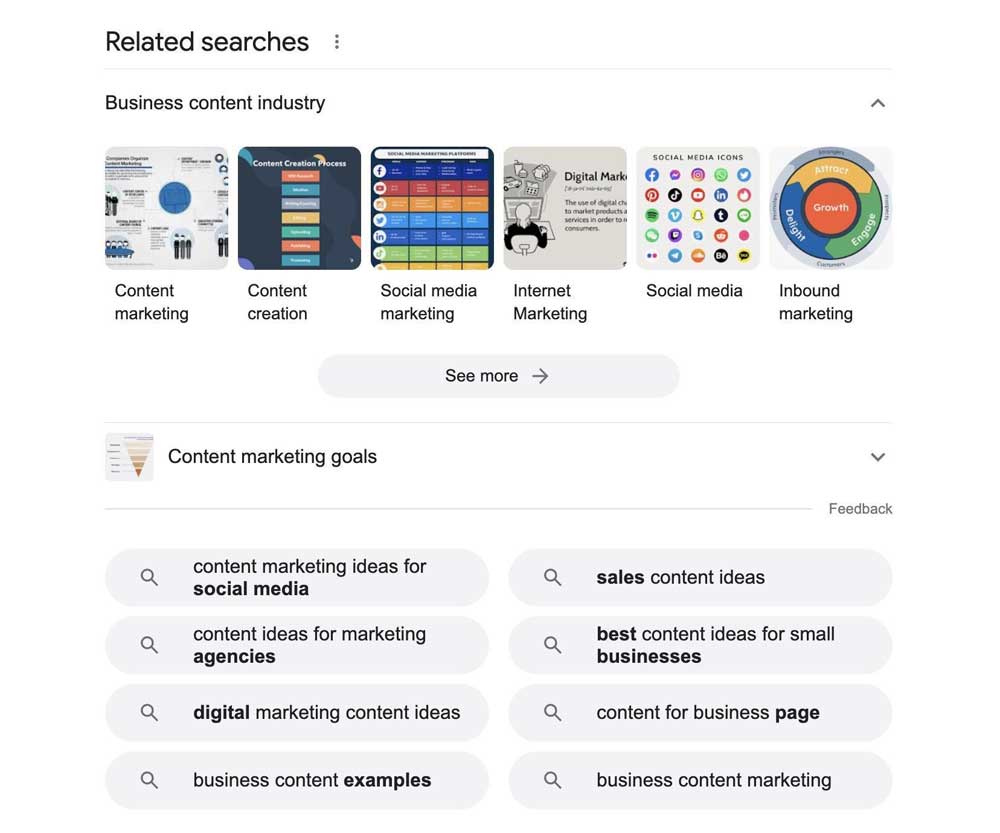
This section usually includes a row of related topics and images that you can click on to explore Image search. You should also see a list of related search queries that you can click on to view relevant results pages.
Remember, at the start of every search query is a person looking for help to find the most suitable solution for their search needs. You want your business to be at the forefront of answering this need in the most complete and useful way possible for your key audience types. Related searches can provide valuable additional insights to achieve this.
Content marketing strategies for small businesses
Once you’ve identified the best content marketing opportunities, it’s time to implement them as working strategies.
Let’s look at some of the most important approaches for small businesses.
Prove your quality with E-E-A-T content
E-E-A-T is an acronym used by Google to help its quality team rate its search results and the pages/content it ranks for queries.
The acronym stands for Experience, Expertise, Authority and Trust.
In Google’s quality guidelines (PDF), the search giant asks raters to assess these four characteristics as follows:
- Experience: “Consider the extent to which the content creator has the necessary first-hand or life experience for the topic”.
- Expertise: “Consider the extent to which the content creator has the necessary knowledge or skill for the topic”.
- Authority: “Consider the extent to which the content creator or the website is known as a go-to source for the topic”.
- Trust: “Consider the extent to which the page is accurate, honest, safe and reliable”.
Note that Google repeats the phrase “for the topic” in reference to experience, expertise and authority. This highlights the importance of E-E-A-T and topical relevance for every individual piece of content you publish.
If you don’t have the experience, expertise and authority to cover a particular topic, you shouldn’t be publishing content on it. If you’re expanding into a new topic, product or service area, it’s important for you to comprehensively showcase your knowledge and value to your audience and support this with trust signals as you build your experience in the new topic.
On the other hand, if you do have the necessary characteristics to publish content on a given topic, then you need to demonstrate it using the following approaches.
- Cover your areas of expertise: Provide in-depth coverage and real insights that offer value to your target audience.
- Create high-quality content: Prioritise quality over quantity in your content marketing strategy.
- Be factual & accurate: Fact-check everything you publish and make sure information is both accurate and up to date.
- Provide plenty of data: Back up key points with insights from reputable sources (stats, figures, etc.).
- Deliver on your promises: Make sure your content delivers on the promises made in your titles, headlines, etc.
- Inform, don’t sell: Use your content to provide audiences with valuable information and motivate them to use it.
- Take it easy with popups & CTAs: If possible, avoid using popups and no more than a few CTAs in the main body of text – roughly one CTA per 1,000 words.
- Show author bios on every post, including:
- Author name
- Author photo
- Credentials
- Links to social profiles
- Network with reputable publishers: Build authority and trust by networking with reputable publishers in your industry.
- Publish interviews with industry experts: This is effective for all elements of E-E-A-T, but it can also help you cover relevant content opportunities outside your areas of expertise.
- Optimise for usability: Make sure your website delivers a positive user experience and optimise for it, including loading times.
Google is placing more emphasis on experience, expertise, authority and trust every year, especially now that AI content tools are going mainstream. The search giant rewards content written by experts over generic or light content that offers nothing more than the basics.
Fore more information, check out this guide on how to optimize each element of E-E-A-T on the Seobility blog.
Create topic clusters to maximise keyword coverage
Topic clusters are a relatively new content marketing strategy that optimises for today’s longer and more specific search queries. Essentially, you create one piece of “pillar content” for each of your most important topics and keywords. Then, you create “cluster” pieces covering sub-topics, related topics, long tail keywords, FAQs and other relevant content opportunities.
The pillar content should provide well-rounded coverage of the topic as a whole, with the cluster pages going into more detail on specific subtopics. Crucially, the pillar page should link to each cluster page with internal links, including descriptive anchor text with the relevant keyword(s).
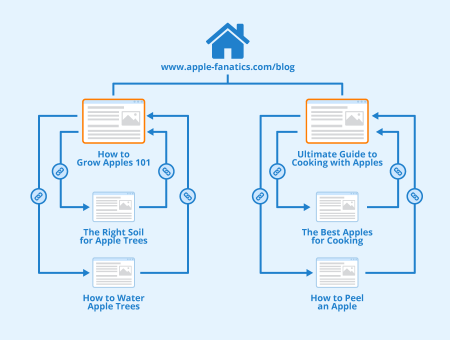
Image author: Seobility, License: CC BY-SA 4.0
Once you’ve created your topic clusters, it’s important to keep each piece of content up to date. Regularly update your pillar content to include the latest information and do the same for your cluster pages, adding new cluster pages for any sub-topics that emerge, such as new trends or technologies.
Run a content audit every year to make sure your content is up to date and check for multiple pages competing for the same keywords. It’s particularly important that you only have one page ranking for your most important keywords to avoid cannibalisation.
You can use Seobility’s website audit tool to check your website for content-related issues such as pages competing for the same keywords.
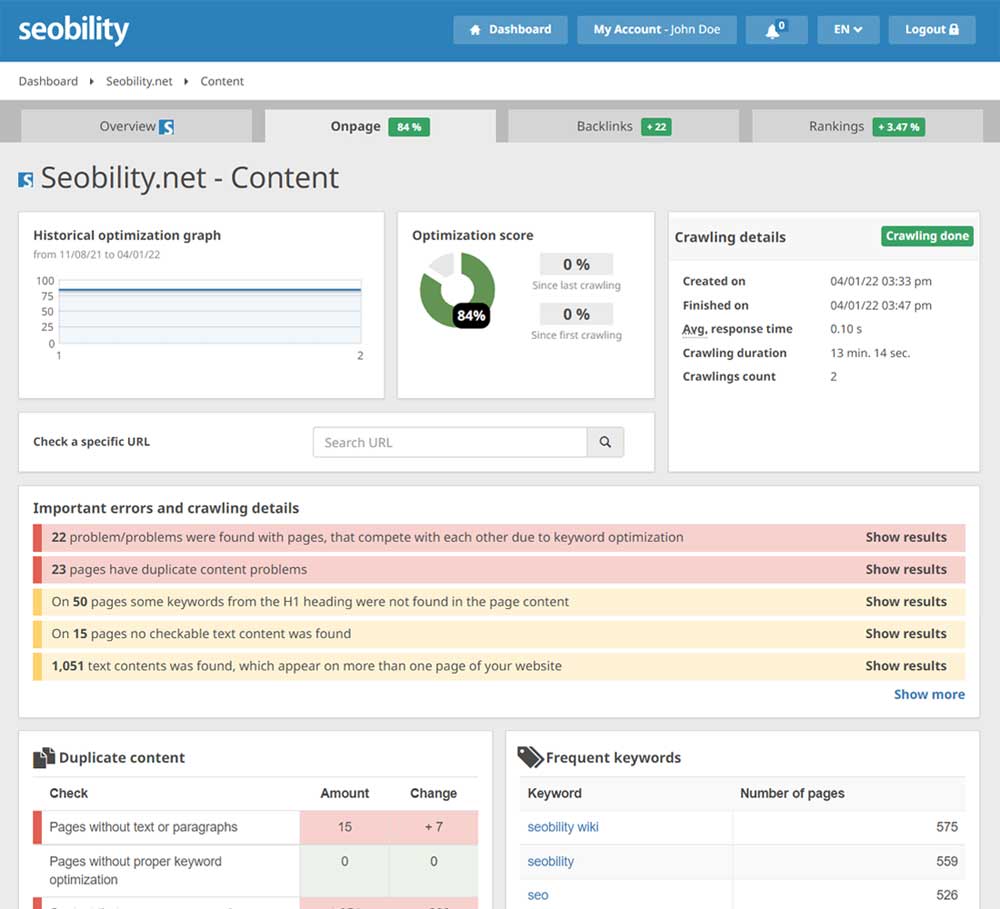
What steps should you take if you discover that you do have more than one page of content optimised for the same keyword?
In this scenario, you want to merge the multiple pages into one piece of content and update it to make sure all of the information is accurate. You may need to reformat the combined content to make it more readable and remove any repetition that may have existed between the original, separate pieces.
Annual audits will take care of any major issues, but you may need to update certain pieces of content more regularly, especially if major events or changes in your industry need to be addressed.
Content ideas for local SEO
Content marketing doesn’t always get enough attention in local SEO strategies. However, it’s important to send as many local signals to search engines as possible if you want to rank for relevant queries as people search in the nearby area.
As a first step in a local SEO strategy, make sure you’ve got the following essentials covered.
- Localise your website: Use local keywords in your page titles, headings and copy.
- NAP details: Include your business name, address and phone number (NAP) on the footer of your website and your contact page.
- Location pages: If you serve multiple locations, create optimised pages for each location.
- Localised blog content: Create blog content for each target location.
- Testimonials from local customers: Add testimonials from local customers to your website and include their location details.
- Network with local publishers: Partner with local publishers to build local links and promote your brand.
- Local news coverage: Get your business featured in local news media by being newsworthy and sending out press releases.
- Organize or get involved in local events: Participate in the local community by holding, sponsoring or participating in local events – and publish content about them.
When these essentials are covered, it’s time to think about your Google Business Profile – arguably, the most important channel in your local search strategy. Now, you may not think of your Business Profile as a content marketing channel, but there are several key roles it can play.
Most importantly, the image gallery in your Business Profile is crucial for showcasing the best side of your business. For some businesses, this is vital. For example, restaurants have a lot to gain by showing off their best food, pictures of the menu, images of the interior and visual content that will encourage people to make a booking.
Take full advantage of this to show the aspects of your business that will attract customers.
Likewise, you can add video clips to your Business Profile. This opens up a range of opportunities, depending on the nature of your business. Restaurants can show clips of food being prepared or served, retailers can show time lapses of products being delivered to customers and barbershops can show before and after videos or the latest styles.
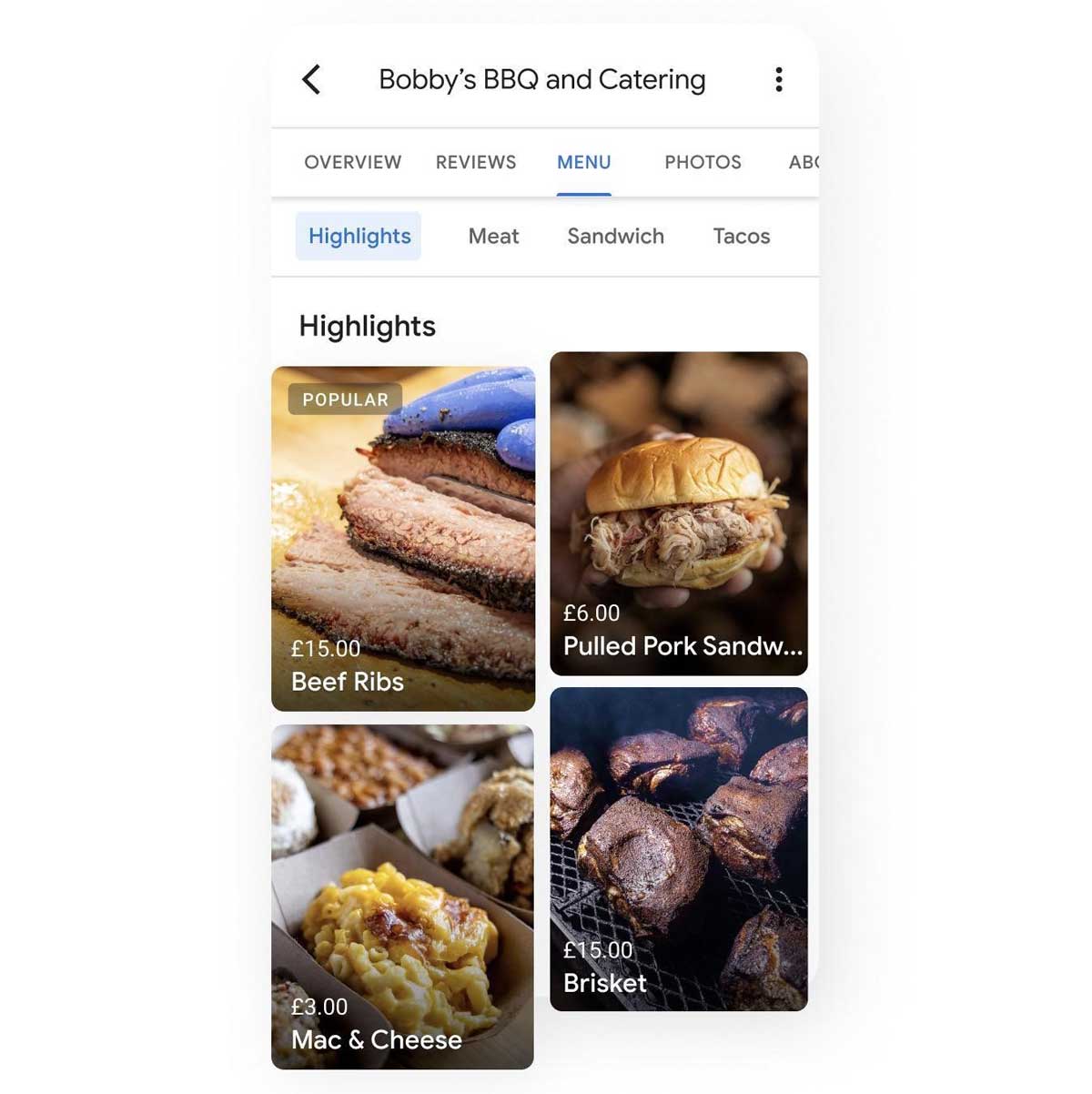
We’ll talk about video content strategies for small businesses in the next section.
First, though, we have to talk about the content opportunities in Google Business Profile that allow you to interact with customers. Customer reviews are the obvious example and it’s important to build a profile of positive feedback. However, it’s also important to interact with customers who leave reviews – either by thanking them for the positive review and/or addressing any issues they raise.
Your Google Business Profile also allows people to ask questions about your business, such as whether you provide certain services or facilities (such as wheelchair access). Like reviews, these questions are shown on your profile for public viewing, so it’s important to interact with people and answer their questions.
Keep in mind that other people can also answer these questions – so get in there first and respond quickly.
Finally, Google also allows you to publish posts on your Business Profile. This is designed to help you post announcements, updates and other important information for customers and potential customers. Posts can include text, photos and video content, so use this channel to engage with local searchers.
Creating video content on a small business budget
Producing video content can be incredibly expensive, but small businesses can get involved without breaking the bank. In the social age, modern consumers want authenticity from companies and they’re interested in seeing the human imperfections behind the scenes – something you can use to your advantage.
If you don’t have the budget to seriously invest in video marketing, get your smartphone out and start making things happen for yourself.
Create personal video content that lifts the lid on your business and shows the human side of how you operate. Make your customers the stars, or the staff who run your businesses on a day-to-day basis.
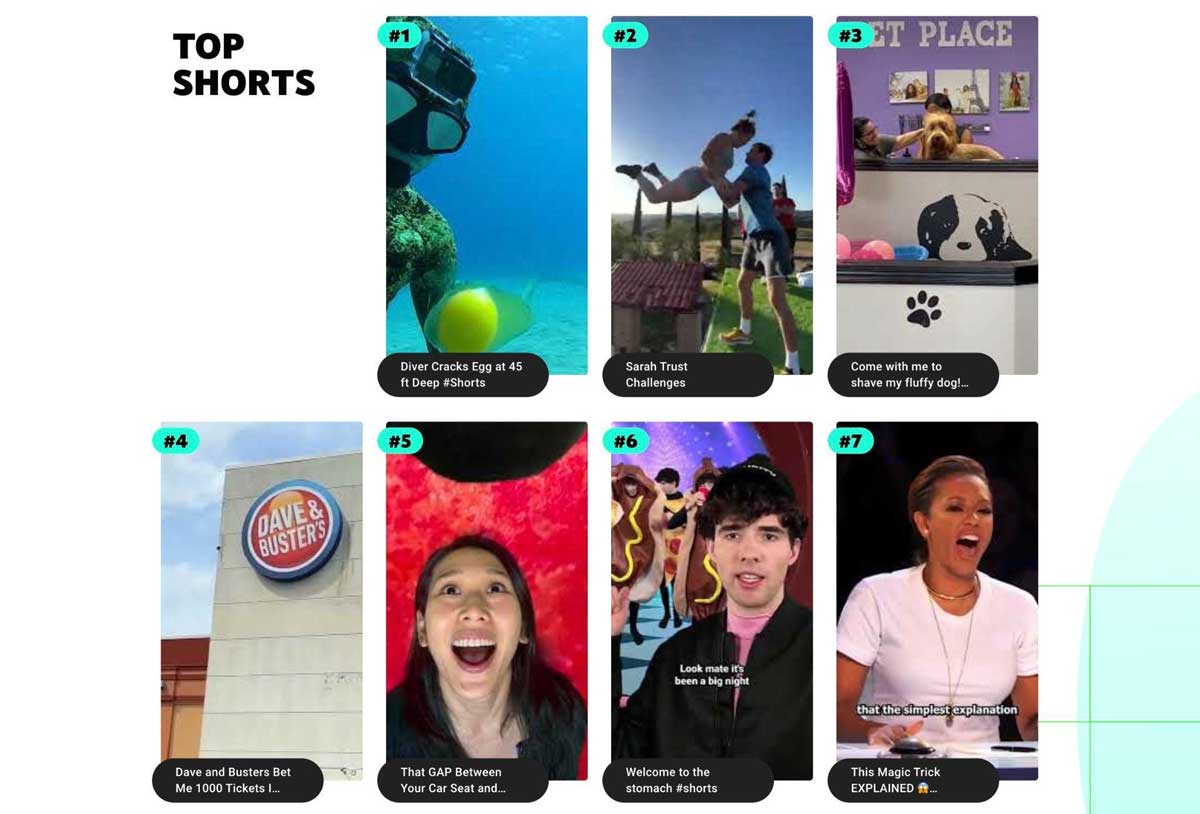
Even for major brands like GAP, personal and authentic video content is what puts them in the top YouTube Shorts for 2022.
Unfortunately, we can’t provide examples for every business type, but the ideas below can hopefully provide some inspiration.
- Restaurants: Recipe videos, highlights from events, clips of where your best produce comes from, etc.
- Retail: Product comparisons, product reviews, unboxing videos for highly-anticipated product releases, etc.
- Fashion: Teaser videos of next season’s items, complete outfit suggestions (combining different products), best outfits or items at different price points (such as date night outfits for under £100).
- Finance: Tax return tutorials, guides to business expenses, VAT tips, etc.
- Logistics: Time-lapse videos of deliveries, videos showcasing safety measures, customer testimonial videos, etc.
- Fitness: Workout videos, daily exercise tips, equipment guides, etc.
If you make video content that’s personal and authentic, audiences won’t care that you’re not using the best camera equipment. Editing is the biggest challenge on a low budget, but there are plenty of video editing tools designed for beginners or for creating short clips for social media.
You don’t need to go to film school or master Adobe Premiere to get started with video marketing.
Tip: Tap into user-generated content by encouraging customers to leave video reviews, their own unboxing videos and other clips that you can use in your content marketing strategy.
Repurpose content to maximise ROI
Repurposing content is key for getting the most from every piece of content you create, especially the more expensive pieces to produce. This involves taking content from one format (e.g. video) and converting it into other formats, such as blogs and social media posts.
Let’s say you’ve created a 30-minute buyer’s guide video for your YouTube channel. Creating quality content takes time, effort and money, so why not get as much content as you can out of the resources you put into creating the buyer’s guide?
For example, you can cut up your YouTube video into short clips for posting across your social accounts. Next, you can repurpose each section as blog posts for your website and use them to promote the video. Then you can take snippets from the video and blog posts to create social media content like Instagram Reels, Twitter Polls and paid ads.
Wistia takes clips from its Talking Too Loud podcast and uses them to inform audiences and promote episodes across social media.
Launching a new product?
It’s key to make sure all parts of the launch, from engineering to marketing, are working together seamlessly. Wistia’s @mrjean and Delphine Mahos discuss on #TalkingTooLoud: https://t.co/SCnVNeZrMR pic.twitter.com/nOfiTYuWul
— Wistia (@wistia) November 28, 2022
For small businesses, repurposing the more expensive content formats can make multimedia content marketing affordable.
Repurposing content isn’t all about saving money, though. It’s equally important that your content reaches people across their favourite platforms, in their preferred format – or wherever they happen to be when they discover it.
By putting your message out across every channel in multiple media formats, your content strategy has the best chance of inspiring people at the crucial moment.
You can also use repurposing as a strategy to maximise the performance of your best content. In our video example, we talked about using blog posts to promote the original YouTube video, and you can do the same thing with your repurposed social content and paid ads.
Another approach is to take your top-performing content in one format and then reproduce it in other formats. For example, you can look at your blog posts that generate the most engagement on social media and repurpose those posts into a series of videos, podcasts or in-depth guides.
Lay the foundations for big business content marketing
Content marketing is a challenge for small businesses, but nobody says you have to do content marketing like a small business. The key to driving real growth with content marketing is laying the foundation as early as possible for implementing a strategy that competes with your biggest rivals.
Earlier, we talked about how to make video marketing more affordable, and it pays to get involved as early as possible. The sooner you start honing your skills with video marketing and getting the most out of your budget, the better placed you’ll be to create high-ROI video campaigns when you’ve got more funds available.
Don’t just think about the kind of content you can create to make an impact today. Plan ahead, consider what you want to produce in the future and work towards it any way you can.
For example, let’s say your biggest competitors are generating a lot of links from data-driven content – their own surveys, studies, investigations, interviews, etc.
You may not have the data or the funds available to produce this kind of content yet, but you can start building towards it. Collect all the relevant data you can, analyse it and start mapping out trends or developments. Establish relationships with customers who you can tap into for feedback and insights. Network with industry peers who you can turn to for interviews and surveys once you’re ready to start publishing this kind of content.
By laying these foundations as early as possible, you’ll develop the resources to do content marketing like a big business much sooner.
Key takeaways from this article
As we’ve covered a lot of information in this article, let’s have a quick recap of the key points we’ve discussed:
- Planning: Develop your content marketing strategy in detail before investing any money in content production.
- Expertise: Demonstrate your expertise in everything you publish with “E-E-A-T” content.
- Topic clusters: Create topic clusters to prioritise your most important keywords, maximise keyword coverage and avoid competing against yourself in the SERPs.
- Local SEO: If you’re a local business, make full use of the content opportunities available to you.
- Multimedia content: Small businesses can make video and other multimedia content in affordable formats.
- Content repurposing: Repurpose your best and most expensive content to maximise performance and ROI.
- Look ahead: Lay the foundations for doing content marketing like a big business from day one and you’ll get there much faster.
This is a good action plan if you’re developing your first small business content strategy or revising your existing one. You might also want to take a look at our posts discussing the top SEO mistakes small businesses should avoid and SEO strategies for different types of small businesses as well as our SEO Checklist for Small Businesses if you’re relatively new to search marketing.
And don’t forget to sign up here for a free 14-day trial of Seobility Premium, so you can take full advantage of the Seobility Keyword Resarch Tool for topic research and the Website Audit to analyse whether your content is optimised for search engines.
PS: Get blog updates straight to your inbox!